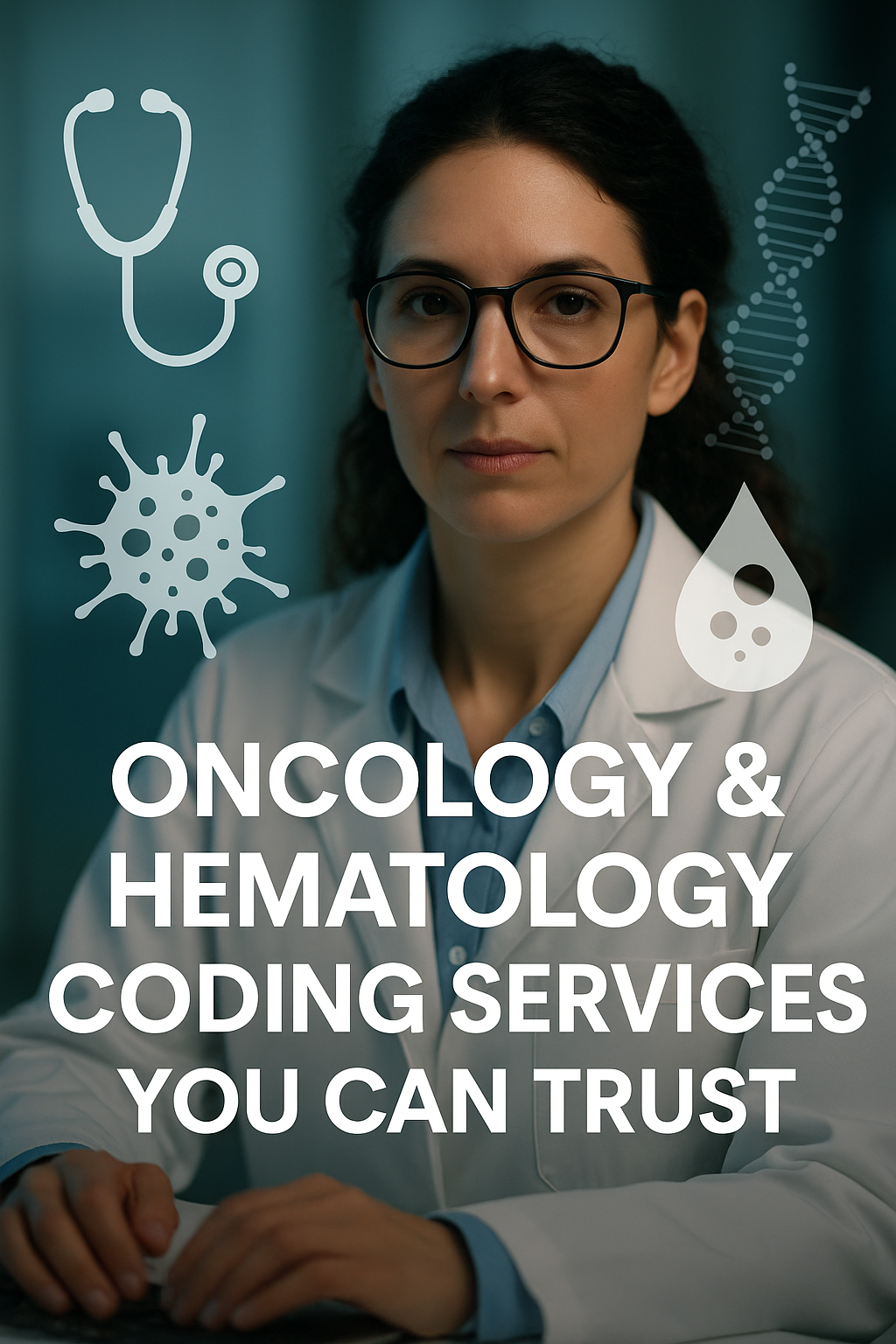Oncology & Hematology Coding Services You Can Trust
Coding Services
Precision, Commitment and Experience for Every Life-Saving Code
Featured Image: Professional healthcare coder working with oncology charts overlaid with DNA and blood cell icons
Coding Services. Oncology and hematology represent more than medical specialties—they are fields where every diagnosis and treatment embodies hope for life. In this clinical environment, precision applies not only to the laboratory or operating room, but also to medical administration and coding.
The complexity of cancer care demands equally sophisticated coding expertise. From initial diagnosis through complex treatment regimens, every procedure, medication, and service must be accurately documented and coded to ensure proper reimbursement and continuity of care.
In this comprehensive guide, we’ll explore the intricate world of oncology and hematology coding: its challenges, importance in treatment continuity, the most relevant CPT and ICD-10 codes, and how specialized can make the difference between an efficient system and one overwhelmed by costly errors.

Why Precise Coding is Critical in Oncology and Hematology
Cancer and blood disorder treatments are extensive, recurrent, multidisciplinary, and expensive. Patients often navigate complex insurance plans, including Medicare, Medicaid, commercial plans, and state assistance programs. Therefore, incorrect coding can:
- Delay life-saving treatments due to claim rejections
- Generate payment denials that strain cash flow
- Trigger costly audits and compliance reviews
- Cause significant revenue loss for medical centers
- Compromise patient care through administrative delays
- Create compliance risks with federal regulations
Oncology coding isn’t just a billing language—it’s a critical bridge between medical care and financial sustainability that directly impacts patient outcomes.
The Financial Impact of Coding Errors
Studies show that oncology practices experience denial rates 15-20% higher than other specialties due to coding complexity. A single miscoded chemotherapy session can result in:
- $2,000-$8,000 in denied claims per patient
- 30-60 day payment delays
- Administrative costs of $150-$300 per correction
- Potential audit triggers affecting entire practice
Common Oncology and Hematology Procedures Requiring Expert Coding
Image: Modern cancer treatment facility showing chemotherapy infusion area with medical equipment
1. Chemotherapy Administration
Chemotherapy coding requires precise understanding of drug types, administration methods, and time documentation:
- 96413: Initial IV chemotherapy administration (up to 1 hour)
- 96415: Each additional hour of IV chemotherapy
- 96417: IV chemotherapy push technique
- 96416: Initiation of prolonged chemotherapy infusion
- 96425: Oral chemotherapy administration with direct supervision

2. Immunotherapy Services
The growing field of immunotherapy presents unique coding challenges:
- 96401: Subcutaneous or intramuscular immunotherapy
- 96413-96417: IV immunotherapy (duration-dependent)
- 96440: Intracavitary or intra-arterial chemotherapy
- 96549: Unlisted chemotherapy procedure
3. Non-Chemotherapeutic Infusions
- 96365-96368: Therapeutic infusions (hydration, antibiotics)
- 96375-96376: Therapeutic injections
- 96377: Application of on-body injector
- 96379: Additional sequential infusions
4. Blood Transfusions and Hematology Services
- 36430: Transfusion of blood or blood components
- P3000: Screening for antibodies, each serum technique
- P3001: Antigen typing for ABO, Rh, or other blood groups
- 86900-86923: Blood typing and crossmatching procedures
5. Vascular Access and Port Management
- 36591: Collection of blood from implanted vascular access device
- 36592: Collection of blood from central venous catheter
- 36576: Repair of central venous access device
- 36578: Replacement of catheter through same venous access
6. Bone Marrow Procedures
- 38220: Bone marrow aspiration only
- 38221: Bone marrow biopsy, needle or trocar
- 38230: Bone marrow harvesting for transplantation
- 38240-38242: Bone marrow or stem cell transplantation

Essential ICD-10 Codes in Oncology and Hematology
Diagnostic coding in oncology requires deep understanding of tumor behavior, staging, location, and treatment history. Here are critical code categories:
Primary Malignancies by System
| Diagnosis | ICD-10 Code | Notes |
|---|---|---|
| Acute myeloid leukemia | C92.0- | Requires 5th digit for subtype |
| Multiple myeloma | C90.00 | Specify location if applicable |
| Breast cancer, right | C50.911 | Laterality required |
| Non-small cell lung cancer | C78.0- | Specify lobe location |
| Non-Hodgkin lymphoma | C85.8- | Multiple subtypes available |
| Pancreatic adenocarcinoma | C25.9 | Head, body, tail specification |
| Prostate cancer | C61 | Single code for organ |
| Ovarian cancer | C56.- | Bilateral specification available |
Secondary Conditions and Complications
| Condition | ICD-10 Code | Clinical Significance |
|---|---|---|
| Drug-induced neutropenia | D70.1 | Common chemo side effect |
| Secondary thrombocytopenia | D69.59 | Monitor for bleeding risk |
| Iron deficiency anemia | D50.9 | May require iron supplementation |
| Chemotherapy adverse effects | T45.1X5A | Document specific drug if known |
| Secondary bone metastases | C79.51 | Affects prognosis and treatment |
Treatment-Related Conditions
- Z51.11: Encounter for chemotherapy
- Z51.12: Encounter for immunotherapy
- Z51.0: Encounter for radiotherapy
- Z08: Encounter for follow-up after cancer treatment
- Z85.-: Personal history of malignant neoplasm
The Critical Role of CPT Modifiers in Oncology
Image: Medical coding specialist reviewing chemotherapy administration records with multiple modifiers
Oncology coding requires precise modifier usage for multiple services during single encounters:
Essential Modifiers
- -59: Distinct procedural service (different anatomic site)
- -25: Significant, separately identifiable E/M service
- -76: Repeat procedure by same physician
- -77: Repeat procedure by another physician
- -JW: Drug amount discarded/not administered
- -SC: Medically necessary service or supply
- -XE: Separate encounter on same date
- -XS: Separate structure during same encounter
Real-World Modifier Application
A patient receiving multiple chemotherapy agents may require:
- Primary infusion (96413)
- Sequential infusion with -59 modifier (96367-59)
- Push administration with -XS modifier (96417-XS)
Incorrect modifier usage can invalidate thousands of dollars in legitimate claims.
What Makes an Oncology Coding Service Trustworthy?
Image: Team of certified medical coders collaborating with oncologists in a modern healthcare setting
✅ Certified and Specialized Personnel
Essential Qualifications:
- CPC (Certified Professional Coder) certification
- COC (Certified Outpatient Coder) specialization
- CPMA (Certified Professional Medical Auditor) credentials
- Minimum 3+ years oncology-specific experience
- Ongoing education in cancer care protocols
✅ Comprehensive Knowledge of Payer Policies
Medicare Expertise:
- National Coverage Determinations (NCDs)
- Local Coverage Determinations (LCDs)
- Medical necessity documentation
- Prior authorization protocols
Commercial Payer Variability:
- Individual plan formularies
- Pre-certification requirements
- Appeals processes
- Value-based care contracts
✅ Proactive Audit and Quality Assurance
Regular Review Processes:
- Pre-claim scrubbing to catch errors before submission
- Denial analysis to identify patterns and prevent recurrence
- Documentation improvement recommendations
- Compliance monitoring for federal regulations
Case Study: Transforming a Cancer Center’s Revenue Cycle
The Challenge
A 50-physician oncology practice experienced:
- 35% initial denial rate for chemotherapy claims
- Average 47-day payment cycles
- $280,000 in outstanding denials over 6 months
- 3 full-time staff members dedicated to denial management



